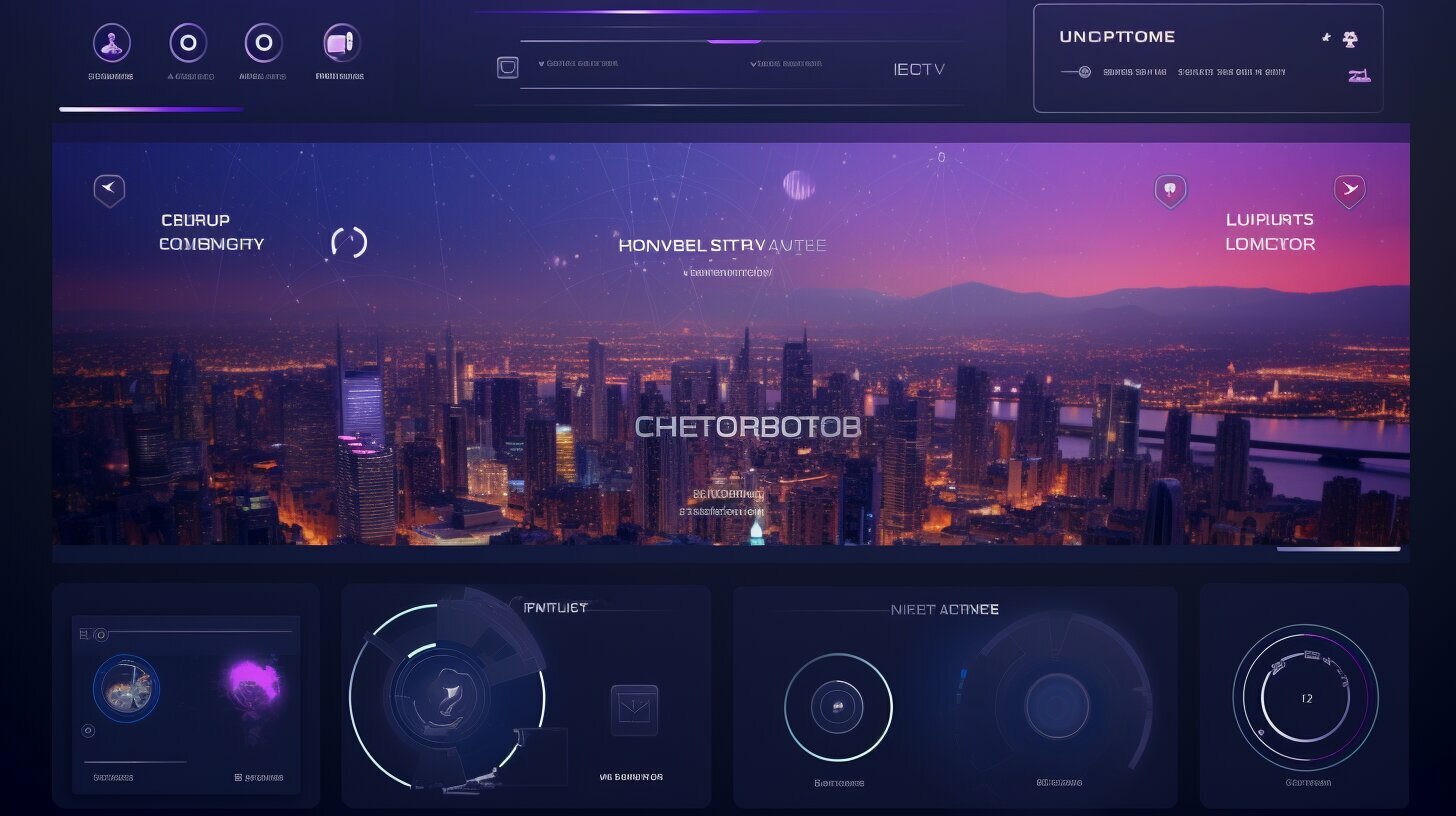Chatbots have revolutionized the customer service industry by offering efficient and effective support solutions, and learning how to use them effectively can greatly benefit your US business. In today’s digital era, where customers expect instant assistance, chatbots provide a valuable tool for businesses to enhance their customer support experience.
Key Takeaways:
- Utilizing chatbots in customer support can improve efficiency and enhance customer satisfaction.
- Chatbots excel at automating repetitive tasks, providing instant replies, and handling large chat volumes.
- However, chatbots have limitations and should be used strategically to ensure successful implementation.
- Integrating chatbots with live chat software can enable businesses to provide real-time and personalized support experiences.
- Following chat etiquette and effectively dividing the workload between chatbots and human support agents are crucial for optimal results.
Understanding the Benefits of Chatbots in Customer Support
Implementing chatbots for customer support can bring numerous advantages to your business, including improved efficiency and enhanced customer experiences. Chatbots excel at providing instant replies, automating frequently asked questions, increasing customer engagement, and efficiently handling large chat volumes. By leveraging chatbots effectively, businesses can optimize their customer support operations and deliver exceptional service.
Automation and Efficiency
One of the key benefits of using chatbots in customer support is the ability to automate repetitive tasks. Chatbots can handle common inquiries and provide instant responses, freeing up human support agents to focus on more complex issues. This automation improves efficiency by reducing response times and allows businesses to handle a higher volume of inquiries simultaneously. With chatbots working around the clock, customers can receive assistance 24/7, ensuring their needs are addressed promptly.
Enhanced Customer Experiences
Chatbots play a crucial role in enhancing customer experiences by providing consistent and personalized support. They can gather relevant customer information, such as previous interactions and purchase history, to offer tailored recommendations and solutions. By leveraging artificial intelligence, chatbots can analyze customer data to anticipate needs, proactively provide assistance, and offer relevant products or services. This level of personalization creates a more engaging and satisfying customer journey, leading to improved customer satisfaction and loyalty.
| Benefits of Chatbots in Customer Support |
|---|
| Automation of repetitive tasks |
| Improved efficiency and shorter response times |
| 24/7 availability |
| Consistent and personalized support |
| Proactive assistance and recommendations |
| Increased customer satisfaction and loyalty |
Handling Large Chat Volumes
In customer support, handling a large volume of chat inquiries can be challenging. This is where chatbots shine, as they can simultaneously engage with multiple customers and provide instant responses. By automating routine tasks and frequently asked questions, chatbots significantly reduce the workload on human support agents, allowing them to focus on more complex or critical issues. With chatbots handling the initial interactions, businesses can efficiently manage and prioritize customer inquiries, ensuring a timely and satisfactory resolution for each customer.
In conclusion, chatbots offer numerous benefits for customer support in terms of automation, efficiency, enhanced customer experiences, and handling large chat volumes. By leveraging these advantages and implementing chatbots effectively, businesses can optimize their support operations, improve customer satisfaction, and gain a competitive edge in the market.
Overcoming Limitations of Chatbots in Customer Support
While chatbots have revolutionized customer support, it’s essential to be aware of their limitations and find ways to work around them for effective implementation. Understanding these limitations can help businesses optimize their chatbot strategies and ensure a seamless customer experience.
One limitation of chatbots is their inability to quickly get to the point. Sometimes, chatbots may provide lengthy responses that can confuse or frustrate customers. To overcome this, businesses should focus on optimizing their chatbot scripts and incorporating natural language processing capabilities to enable concise and effective communication.
Another challenge with chatbots is their inability to bend rules or make exceptions. Since chatbots follow predefined rules and algorithms, they may struggle with unconventional or complex customer requests. To address this, businesses can integrate chatbots with human agents, allowing them to handle complex queries while chatbots handle routine tasks and respond to frequently asked questions.
Additionally, chatbots may face difficulties in understanding ambiguous or context-specific questions. They rely on predefined keywords and patterns to identify user intent, which can lead to misinterpretation. To mitigate this limitation, businesses can leverage machine learning algorithms and train chatbots to recognize and understand a wider range of customer queries, improving their accuracy and problem-solving ability.
| Limitation | Workaround |
|---|---|
| Long and confusing responses | Optimize chatbot scripts for concise communication |
| Inability to make exceptions | Integrate chatbots with human agents for complex queries |
| Difficulty in understanding ambiguous questions | Train chatbots with machine learning algorithms for improved accuracy |
Despite these limitations, chatbots are invaluable tools for enhancing customer support. By strategically implementing chatbots where they make sense, businesses can leverage their benefits while mitigating their limitations. By combining chatbots with human agents, dividing workload efficiently, connecting chatbots with live chat software, and following chat etiquette, businesses can provide exceptional customer assistance and improve overall customer satisfaction.
Implementing Effective Chatbot Strategies
To maximize the potential of chatbots in customer service, businesses should adopt effective strategies for implementation. Here are some key tips:
- Clearly define the scope and purpose of chatbots in your customer support strategy.
- Regularly review and update chatbot scripts to ensure accurate and up-to-date information.
- Train chatbots to handle frequently asked questions and provide relevant responses.
- Integrate chatbots with live chat software for seamless transitions between automated and human-assisted support.
- Monitor and analyze chatbot interactions to identify areas for improvement and optimize performance.
By implementing these strategies and continuously refining chatbot capabilities, businesses can effectively overcome limitations and harness the power of chatbots to enhance their customer support operations.
Using Chatbots Where it Makes Sense
To leverage the power of chatbots in customer support, it’s crucial to identify the areas where they can offer the most value and seamlessly integrate them into your support processes. Chatbots excel at automating repetitive tasks, providing instant responses, and handling large volumes of chat. Here are some key areas where chatbots can make a significant impact:
- Frequently Asked Questions: One of the most effective use cases for chatbots is automating responses to frequently asked questions. By programming chatbots to provide instant answers to common queries, businesses can save time and resources while delivering quick and accurate support to their customers.
- Lead Generation: Chatbots can be utilized to engage website visitors and qualify leads by collecting relevant information and providing personalized recommendations. By integrating chatbots into lead generation processes, businesses can efficiently capture and nurture potential customers.
- 24/7 Support: Customer support plays a crucial role in customer satisfaction. By implementing chatbots, businesses can ensure round-the-clock support, even outside of regular working hours. This can be particularly valuable for global organizations with customers in different time zones.
While chatbots offer significant benefits in these areas, it’s important to recognize their limitations. Chatbots may struggle with understanding ambiguous or complex questions, and they may not always have the right answers. That’s why it’s crucial to have human support agents available to step in when necessary.
By effectively using chatbots in customer support and combining their capabilities with human agents, businesses can create a seamless and efficient customer experience. This can lead to higher customer satisfaction, increased productivity, and ultimately, improved business outcomes.
Table: Chatbot Integration in Customer Support
| Benefits | Examples |
|---|---|
| Automate repetitive tasks | Answering frequently asked questions |
| Provide instant responses | Offering real-time support |
| Handle large volumes of chat | Managing high customer demand |
By strategically implementing chatbots and maximizing their capabilities in the right areas, businesses can enhance their customer support processes, improve efficiency, and deliver exceptional experiences to their customers.
Making Human Support Agents Stand Out
While chatbots play a significant role in customer support, it’s equally important to ensure that your human support agents stand out and provide personalized assistance when needed. Chatbots excel at automating repetitive tasks, but human agents bring empathy, critical thinking, and problem-solving skills to customer interactions. By combining the strengths of both chatbots and human agents, businesses can deliver exceptional customer support experiences.
One way to make human support agents stand out is by training them to handle complex and delicate situations that require a human touch. These situations may involve emotional customers, resolving unique issues, or providing product recommendations based on individual needs. By empowering human agents with specialized knowledge and training, businesses can offer personalized assistance that goes beyond what chatbots can provide.
Another strategy to differentiate human support agents is by leveraging their ability to create authentic connections with customers. While chatbots can mimic human-like interactions, customers often appreciate the genuine empathy and understanding that comes from interacting with a real person. Human agents can actively listen, show empathy, and tailor their responses to each customer, fostering stronger customer relationships and loyalty.
In addition, businesses should ensure that the chatbot-human agent handover is seamless and well-coordinated. This means designing systems and processes that allow chatbots to transfer conversations to human agents seamlessly and provide them with the context necessary to continue the interaction smoothly. This way, customers receive a consistent and uninterrupted support experience, with the chatbot laying the groundwork and the human agent stepping in when necessary.
In conclusion, while chatbots offer numerous benefits in customer support, it’s essential to remember the unique value that human support agents bring to the table. By training human agents to handle complex situations, fostering authentic connections with customers, and facilitating a seamless handover between chatbots and human agents, businesses can ensure that their human support agents stand out and provide exceptional personalized assistance when it matters most.
Efficient Workload Division
Finding the right balance between chatbots and human support agents is essential to ensure efficient workload division and seamless customer support interactions. Implementing chatbots for customer service can significantly reduce the workload of human agents by automating repetitive tasks and providing quick responses to frequently asked questions. This allows human agents to focus on more complex inquiries and provide personalized assistance to customers.
One effective strategy for workload division is to utilize chatbots for initial customer interactions, such as greeting customers, collecting basic information, and providing general assistance. Chatbots can quickly handle high volumes of incoming messages, ensuring that customers receive prompt responses.
However, it is crucial to recognize that there are limitations to chatbot capabilities. In situations where the chatbot is unable to provide a satisfactory response or when customers require a more personalized touch, human support agents should be ready to intervene and provide assistance. Human agents can handle complex issues, empathize with customers, and offer tailored solutions that chatbots may struggle to deliver.
To maintain a seamless customer experience, businesses can integrate chatbots with live chat software. This integration allows chatbots to transfer conversations to human agents seamlessly when necessary. Live chat software also enables human agents to review previous interactions with customers, ensuring continuity and avoiding repetitive questions.
| Benefits of Efficient Workload Division: |
|---|
| Saves time by automating repetitive tasks |
| Improves response time for customer inquiries |
| Provides personalized assistance for complex issues |
| Maintains a seamless customer experience |
Best Practices for Efficient Workload Division:
- Identify the types of inquiries that can be effectively handled by chatbots
- Train chatbots to recognize when human intervention is necessary
- Ensure smooth communication handover between chatbots and human agents
- Regularly review and update chatbot responses to improve accuracy and effectiveness
- Monitor chatbot performance and customer feedback to identify areas for improvement
Connecting Chatbots with Live Chat Software
Integrating chatbots with live chat software allows businesses to offer instant support and personalized experiences, enhancing customer satisfaction and loyalty. By combining the capabilities of chatbots and live chat software, businesses can provide real-time responses and tailored solutions to customer queries, creating a seamless and efficient support experience.
When chatbots are connected with live chat software, they can handle initial customer interactions, automating repetitive tasks and providing quick answers to frequently asked questions. This frees up human support agents to focus on more complex issues, ensuring that customers receive the attention they deserve.
Furthermore, the integration of chatbots and live chat software enables businesses to handle large chat volumes effectively. Chatbots can handle multiple conversations simultaneously, ensuring that customers do not have to wait in long queues to receive assistance. This reduces customer frustration and enhances overall satisfaction.
| Benefits of Chatbot Integration with Live Chat Software |
|---|
| Instant support |
| Personalized experiences |
| Efficient handling of repetitive tasks |
| Quick answers to frequently asked questions |
| Reduced waiting times for customers |
By integrating chatbots with live chat software, businesses can harness the power of AI-driven automation while still providing a human touch. This combination allows companies to deliver exceptional customer support, increase customer satisfaction, and build long-lasting loyalty.
Following Chat Etiquette
To provide exceptional customer support using chatbots, it’s vital to follow chat etiquette guidelines to create positive and meaningful interactions. Chatbots are powerful tools for improving customer support, but without proper etiquette, there is a risk of frustrating or alienating customers. Here are some key guidelines to keep in mind:
- Be clear and concise: When interacting with customers, make sure the chatbot’s responses are clear and easy to understand. Avoid using complex language or jargon that may confuse the customer.
- Provide personalized responses: Customize the chatbot’s responses to each customer’s specific needs. Use customer data and previous interactions to offer tailored solutions or recommendations.
- Respond promptly: Aim to reply to customer inquiries as quickly as possible. Customers appreciate prompt responses, even if it’s just to acknowledge their query and let them know that their issue is being addressed.
- Show empathy: Although chatbots may lack human emotions, it’s essential to convey empathy in their responses. Use empathetic language and phrases to show understanding and make customers feel heard.
While following chat etiquette is crucial, it’s also important to strike a balance between chatbot and human interactions. Sometimes, a chatbot may not be able to fully resolve a customer’s issue. In such cases, it’s important to seamlessly transition the customer to a human support agent. This ensures that the customer feels valued and receives the necessary assistance.
Case Study: Improving Customer Satisfaction Through Chat Etiquette
“By implementing chat etiquette guidelines and training our chatbots to provide personalized and empathetic responses, we saw a significant increase in customer satisfaction. Customers appreciated the quick and accurate information provided by our chatbots, which in turn reduced their wait time and improved overall support efficiency.”
To summarize, following chat etiquette is crucial for businesses looking to utilize chatbots to improve customer support. By adopting clear and concise language, providing personalized responses, responding promptly, and showing empathy, businesses can enhance customer satisfaction and create positive interactions. By leveraging chatbots alongside human support agents, businesses can create a seamless customer support experience that blends automation and human touch.
| Key Takeaways |
|---|
| Follow chat etiquette guidelines to create positive and meaningful interactions with customers. |
| Be clear and concise in the chatbot’s responses. |
| Personalize responses and provide tailored solutions when possible. |
| Respond promptly to customer inquiries, even if it’s just to acknowledge the query. |
| Show empathy in language and responses. |
| Seamlessly transition customers to human support agents when necessary. |
Improving Customer Satisfaction with Chatbots
By leveraging the capabilities of chatbots, businesses can significantly improve customer satisfaction by offering prompt responses, personalized recommendations, and proactive support. Chatbots excel at replying instantly to customer queries, ensuring that no customer is left waiting for a response. This quick and efficient communication demonstrates to customers that their time is valued, leading to higher levels of satisfaction.
Additionally, chatbots can provide personalized recommendations based on customer preferences and previous interactions. By analyzing customer data, chatbots can offer tailored suggestions, helping customers discover products or services that align with their interests. This personalized approach enhances the overall customer experience, making them feel valued and understood.
Chatbots are also effective in providing proactive support to customers. By anticipating their needs and addressing potential issues before they arise, chatbots can offer a seamless customer journey. For example, chatbots can proactively reach out to customers who have abandoned their shopping carts, offering assistance or incentives to complete their purchase. These proactive interactions demonstrate a commitment to customer satisfaction and can help increase customer loyalty.
| Benefits of Using Chatbots to Improve Customer Satisfaction |
|---|
| 1. Prompt responses to customer queries |
| 2. Personalized recommendations based on customer preferences |
| 3. Proactive support to address potential issues before they arise |
In conclusion, chatbots offer businesses a powerful tool to enhance customer satisfaction. Through their ability to provide prompt responses, personalized recommendations, and proactive support, chatbots can create a positive and efficient customer experience. By leveraging chatbot solutions for customer service, businesses can build stronger relationships with their customers and improve overall satisfaction levels.
Reducing Costs with Chatbots
Implementing chatbots in customer support can lead to significant cost savings for businesses through automation, reduced staffing needs, and round-the-clock availability. By automating repetitive tasks, such as answering frequently asked questions, chatbots can free up human support agents to focus on more complex and specialized issues. This not only increases the efficiency of the support team but also allows businesses to handle larger chat volumes without the need for additional staff.
Using chatbots to handle customer inquiries 24/7 also eliminates the need for round-the-clock staffing. Customers can receive instant responses and assistance regardless of the time of day, improving their overall experience and satisfaction. This constant availability also means that businesses can reduce the number of support agents needed to cover shifts, resulting in significant cost savings.
| Benefits of Chatbots for Reducing Costs: |
|---|
| 1. Automation of repetitive tasks |
| 2. Reduced need for additional support agents |
| 3. 24/7 availability for customers |
Furthermore, chatbots can provide cost savings by preventing potential revenue loss. By engaging customers, providing personalized recommendations, and facilitating transactions, chatbots can help drive sales and generate leads. This can have a direct impact on the bottom line of businesses, further enhancing the cost-effectiveness of chatbot integration in customer support.
In conclusion, implementing chatbots in customer support offers numerous benefits for businesses, including significant cost savings. Automation, reduced staffing needs, and round-the-clock availability are key factors that contribute to these cost savings. By leveraging chatbots effectively, businesses can streamline their customer support operations and achieve improved efficiency and profitability.
Enhancing Customer Loyalty
Chatbots have the potential to foster strong customer loyalty by delivering consistent, personalized, and efficient support experiences across multiple channels. By leveraging chatbots in customer service, businesses can enhance their relationship with customers and create a positive brand image.
One of the key benefits of chatbots in enhancing customer loyalty is their ability to provide consistent support experiences. Unlike human agents who may vary in their responses and availability, chatbots offer a standardized level of service. They can provide accurate and timely information, ensuring that customers receive the same quality of assistance every time they interact with the chatbot.
Furthermore, chatbots can personalize the support experience by collecting and utilizing customer data. They can access past interactions, purchase history, and preferences to offer tailored recommendations and solutions. This level of personalization makes customers feel valued and understood, strengthening their connection with the brand.
Additionally, chatbots enable businesses to provide efficient support experiences, which contributes to customer loyalty. They can handle multiple chat sessions simultaneously, reducing wait times and ensuring prompt responses. With their ability to automate repetitive tasks and answer frequently asked questions, chatbots free up human agents to focus on more complex issues, further improving the overall support experience.
| Benefits of Chatbots in Enhancing Customer Loyalty |
|---|
| Consistent support experiences |
| Personalized recommendations and solutions |
| Efficient handling of multiple chat sessions |
Generating Leads and Sales
With their ability to engage customers, provide personalized recommendations, and facilitate transactions, chatbots can significantly contribute to lead generation and sales growth. By leveraging intelligent algorithms and data analytics, chatbots can analyze customer preferences and behaviors to offer tailored product suggestions and promotions, enhancing the overall customer experience.
One effective strategy for using chatbots to generate leads and drive sales is through proactive engagement. Chatbots can initiate conversations with customers, offering assistance, and guiding them through the purchase process. They can provide real-time support, answer queries, and address any concerns, ensuring customers have a seamless and personalized experience.
Additionally, chatbots can play a vital role in customer retention and cross-selling. By tracking customer interactions and purchase history, chatbots can identify upsell and cross-sell opportunities, presenting relevant products or services to customers during their conversations. This targeted approach can lead to increased sales and higher customer satisfaction.
| Benefits of using Chatbots for generating leads and sales |
|---|
| 1. Personalized recommendations based on customer preferences |
| 2. Proactive engagement to guide customers through the purchase process |
| 3. Real-time support and assistance |
| 4. Upsell and cross-sell opportunities for increased sales |
Case Study: Company X
“By implementing chatbots in our customer support, we were able to increase our lead generation by 35% and boost sales by 20%. The chatbots provided personalized recommendations to our website visitors, resulting in a higher conversion rate. Additionally, the proactive engagement of chatbots helped us guide customers through the sales funnel, ensuring a smooth and efficient purchase process. The integration of chatbots with our CRM system also allowed us to track customer interactions and identify cross-selling opportunities, further contributing to our sales growth.”
In conclusion, chatbots have emerged as valuable tools for businesses to improve lead generation and drive sales. With their ability to engage customers, provide personalized recommendations, and facilitate transactions, chatbots can deliver exceptional experiences that increase customer satisfaction and ultimately lead to business growth.
Fostering Innovation and Differentiation
By leveraging chatbots in customer support, businesses can foster innovation, differentiate themselves from competitors, and stay ahead in today’s fast-paced market. Chatbots offer a range of capabilities that can drive forward-thinking companies to new levels of success.
One way chatbots promote innovation is by providing businesses with the opportunity to experiment with new customer engagement strategies. With chatbots, companies can introduce interactive elements such as quizzes, surveys, and personalized recommendations, enhancing the overall customer experience. By gathering valuable data and insights from these interactions, businesses can continuously improve their products and services, staying at the forefront of customer needs and preferences.
In addition to fostering innovation, chatbots also enable businesses to differentiate themselves from competitors. With a unique and personalized chatbot experience, companies can leave a lasting impression on customers. By offering tailored solutions and anticipating customer needs, chatbots can create memorable interactions that set businesses apart from their competitors. This differentiation can lead to increased customer loyalty and brand advocacy, ultimately driving growth and profitability.
| Benefits | Chatbot Integration for Customer Support |
|---|---|
| Improved efficiency | chatbots automate repetitive tasks, allowing human support agents to focus on more complex issues |
| Enhanced customer satisfaction | chatbots provide quick and accurate responses, personalized recommendations, and proactive assistance |
| Reduced costs | chatbots eliminate the need for additional support agents and provide 24/7 support |
In conclusion, chatbots have the potential to revolutionize customer support in the US. By embracing chatbot integration for customer support, businesses can foster innovation, differentiate themselves from competitors, and ultimately drive growth and success in today’s fast-paced market. With their ability to automate tasks, provide personalized experiences, and enhance customer satisfaction, chatbots are a valuable tool for businesses looking to stay ahead and deliver exceptional customer support.
Implementing Effective Chatbot Strategies
Implementing chatbots successfully requires careful planning and execution, and this section will provide valuable strategies and tips to help businesses achieve optimal results. By following these guidelines, businesses can harness the power of chatbots to improve customer service and enhance the overall customer experience.
1. Use chatbots where it makes sense: It’s important to identify the areas of customer support where chatbots can provide the most value. Chatbots excel at handling repetitive and straightforward tasks, such as answering frequently asked questions or providing basic product information. By deploying chatbots in these areas, businesses can free up human agents to focus on more complex and personalized tasks.
2. Make your human support agents stand out: While chatbots can handle many customer inquiries, there will always be situations that require human intervention. It’s crucial to ensure that your human support agents are well-trained, equipped with the necessary knowledge and tools, and ready to provide exceptional customer service. By combining the strengths of chatbots and human agents, businesses can deliver a seamless and personalized support experience.
3. Divide the workload efficiently: Balancing the workload between chatbots and human agents is key to achieving maximum efficiency. Analyze the volume and nature of customer inquiries to determine the appropriate allocation of tasks. Chatbots can handle low-level queries, while complex or sensitive issues can be escalated to human agents. Regularly review and adjust the workload distribution to ensure smooth operations and customer satisfaction.
| Benefits of Implementing Effective Chatbot Strategies |
|---|
| Improved customer satisfaction |
| Reduced costs through automation |
| Enhanced customer loyalty |
| Increased lead generation and sales |
| Fostered innovation and differentiation |
4. Connect chatbots with live chat software: Integrating chatbots with live chat software allows businesses to offer real-time support and provide personalized experiences. When a chatbot reaches its limit or encounters a complex query, it can seamlessly transfer the conversation to a human agent. This integration ensures that customers receive prompt and accurate assistance, leading to higher satisfaction levels.
To sum up, implementing chatbots for customer service requires a strategic approach. By using chatbots where they can provide the most value, making human agents stand out, efficiently dividing the workload, and connecting chatbots with live chat software, businesses can leverage chatbots to enhance customer support and achieve their goals. With careful planning and execution, chatbots can improve customer satisfaction, reduce costs, foster innovation, and differentiate businesses in the competitive landscape.
Conclusion
Chatbots have become a game changer in customer support, offering businesses in the US the opportunity to improve efficiency, enhance customer experiences, and reduce costs, ultimately leading to greater success in today’s competitive landscape.
With their ability to reply instantly, automate frequently asked questions, and handle large chat volumes, chatbots excel at providing quick and accurate responses, saving time for both customers and support agents. By automating repetitive tasks, businesses can free up their human agents to focus on more complex work, ensuring that customers receive the attention they need for personalized and high-quality interactions.
While chatbots have their limitations, such as not always being able to understand ambiguous questions or create natural interactions, businesses can overcome these challenges by implementing chatbots strategically. By using chatbots where it makes sense and making their human support agents stand out, businesses can ensure a seamless and efficient customer support experience.
Integrating chatbots with live chat software can also provide real-time support and personalized experiences to customers, further enhancing their satisfaction. Following chat etiquette and dividing the workload effectively between chatbots and human agents will help businesses maintain professionalism and deliver exceptional customer service.
Furthermore, chatbots offer additional benefits such as reducing costs by automating tasks and providing 24/7 support, enhancing customer loyalty through consistent and personalized interactions, generating leads and sales by engaging customers and facilitating transactions, and fostering innovation and differentiation, allowing businesses to gain a competitive edge in the market.
By optimizing their customer support with chatbots, businesses in the US can leverage this technology to streamline operations, improve customer satisfaction, and achieve long-term success in the ever-evolving business landscape.
FAQ
Q: What are the benefits of using chatbots in customer support?
A: Chatbots can improve efficiency, enhance customer satisfaction, reduce costs, generate leads and sales, foster innovation, and differentiate businesses in the customer service industry.
Q: What are the limitations of chatbots in customer support?
A: Chatbots may not always get to the point quickly, bend the rules, have all the answers, understand ambiguous questions, or create natural interactions.
Q: Where should businesses use chatbots effectively?
A: Chatbots should be used where it makes sense, such as automating frequently asked questions, handling large chat volumes, and providing 24/7 support.
Q: How can businesses make their human support agents stand out?
A: By utilizing chatbots as a complement to human support agents, businesses can leverage their unique abilities and expertise to provide exceptional customer support.
Q: How can businesses efficiently divide the workload between chatbots and human support agents?
A: Businesses can divide the workload efficiently by identifying the tasks that can be handled by chatbots and those that require human intervention, ensuring optimal productivity and customer satisfaction.
Q: Why is it important to connect chatbots with live chat software?
A: Connecting chatbots with live chat software enables businesses to provide real-time support, personalized experiences, and seamless transitions between automated and human-assisted interactions.
Q: What are the best practices for chat etiquette when using chatbots in customer support?
A: Following chat etiquette involves being professional, courteous, and customer-friendly in interactions with customers, whether they are assisted by chatbots or human support agents.
Q: How can chatbots improve customer satisfaction?
A: Chatbots can improve customer satisfaction by providing instant responses, automating frequently asked questions, offering personalized recommendations, and offering proactive assistance.
Q: How can chatbots reduce costs for businesses?
A: Chatbots can reduce costs by automating repetitive tasks, reducing the need for additional support agents, and providing 24/7 support without incurring additional labor costs.
Q: How can chatbots enhance customer loyalty?
A: By providing consistent and personalized support experiences, chatbots can contribute to building stronger customer loyalty and satisfaction.
Q: How can businesses use chatbots to generate leads and increase sales?
A: Chatbots can engage customers, provide product recommendations, and facilitate transactions, ultimately contributing to lead generation and increased sales for businesses.
Q: How can businesses leverage chatbots to foster innovation and differentiation?
A: By implementing chatbots effectively, businesses can leverage their capabilities to foster innovation, create unique customer experiences, and differentiate themselves in the market.
Q: What are some practical strategies for implementing chatbots effectively in customer support?
A: Practical strategies include using chatbots where they can provide the most value, integrating them with live chat software, and ensuring proper training and monitoring to optimize their performance.







